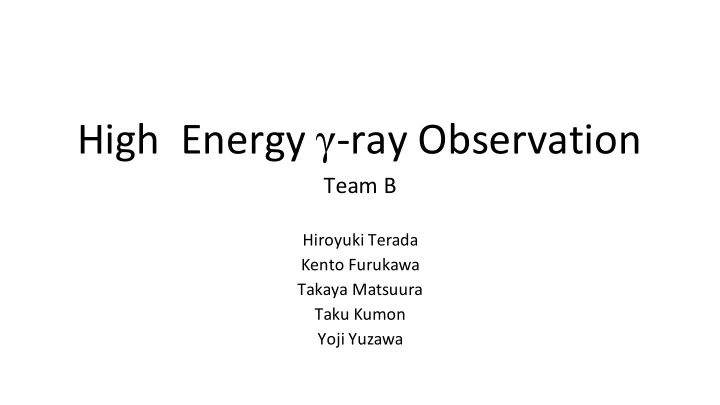

High Energy γ -ray Observation Team B Hiroyuki Terada Kento Furukawa Takaya Matsuura Taku Kumon Yoji Yuzawa
Index 1.Introduction 2.Set up 3.Calibration 4.Observation 5.Analysis & Discussion 6.Future Prospects 7.Conclusion
1.Introduction
1.1 Abstract High energy gamma -rays produce electromagnetic showers in the top of the atmosphere. Electromagnetic showers emit Cherenkov lights. We have build Atmospheric Cherenkov Telescope, observed and analyzed the result.
1.2 How to detect? ・ Capture the image of cherenkov light using reflection mirror 1.3 Task ・ Build Atmospheric Cherenkov Telescope ・ Detect Cherenkov emission ・ Observe Crab Nebula
2. Setup
2.1 Specs ・ spherical mirror(radius:3.3m) ・ Focal length: 1.66 m ・ Point Spread Function: < 1cm ・ Field of view 5° (we calculated) ・ Calculate focal point and set the camera in the position ・ Confirm that each module covers the entire mirror
2.2 Camera Consists of - 7 PMTs (light sensor) with high quantum efficiency - 2 level Trigger system - Readout based on DRS4
2.3 Trigger system ・ Data should be acquired when the large signal comes →Trigger is needed ・ The signal from PMT is sent to detector and trigger ・ Trigger consists of two stages , L0 and L1 ・ First stage(L0) is to sum up signals from all PMTs, large signals from PMT are clipped ・ Second stage(L1) triggers when the output of L0 exceeds the threshold, and then detector preserves the data
3. Calibration
3.1How to calibrate? ・ Adjust HV to make flat field ・ Method 1.in the Dark room 2.Spot isotropic light using Semiconductor laser 3.Collect and analyze data to determine the appropriate HV for each PMT
3.2 Pulse Shape with 1 Gsample /s
3.3 Calculating gain from the data Method1 Compare the peak height Method2 Compare the peak integration
3.4 Flat fielding Before ・ Gain is aligned by adjusting HV After
4. Observation
4.1 Observation ・ Set HV and threshold to suited values ・ Point the telescope to the zenith angle (Watching Leo Minor) 2016 March 10th Cloudy PM9:15~PM10:40 Moon phase: 1.0
5.Analysis and Discussion
5. 1 L0 and L1 Scan ( to adjust threshold) ・ Event rate vs L0(small point) L1(large point) 1e+07 Threshold data of each PMT before L0 1e+06 L1 system and after L1 L0 (PMT0-6) 100000 ・ Event rates were Rate [Hz] 10000 Poisson because of artificial light 1000 ・ The inclination of 100 L1 is about twice as 10 large as that of L0 1 0 50 100 150 200 250 300 350 400 450 Threshold [mV]
5. 1 L0 and L1 Scan ( to adjust threshold) ・ Event rate vs L0(small point) L1(large point) 1e+07 Threshold data of each PMT before L0 1e+06 L1 system and after L1 L0 (PMT0-6) 100000 ・ Event rates were Threshold for Rate [Hz] 10000 Poisson because of data taking artificial light 1000 ・ The inclination of 100 L1 is about twice as 10 large as that of L0 1 0 50 100 150 200 250 300 350 400 450 Threshold [mV]
DC current vs time 200 A] 5.2 Data rate, DC vs Time µ Anode Current [ 180 160 140 120 100 Correlation of data rate vs time and DC vs time 80 10 20 30 40 50 60 70 80 time [min] They are totally coincident.
5.3 Beautifulness We triggered 1500 events in one hour !
5.4 Beautifulness Bad events, not including cherenkov light
5.4 Beautifulness
5. 4 Beautifulness
5. 4 Beautifulness 15 events detected !
5. 4 Beautifulness Events catching cherenkov lights
5. 5 Light Curve We caught 15 events from our observation!!
DC current vs time 200 A] µ 5.6 Light Curve Anode Current [ 180 160 140 120 100 The events occurred when DC 80 current was high 10 20 30 40 50 60 70 80 time [min] It may because the height of the clouds changed (Clouds in the higher sky may reflect the city light while clouds near the ground shut it out )
DC current vs time 200 A] µ Anode Current [ 180 5.7 NSB rate from DC vs L0 Scan 160 140 120 100 80 10 20 30 40 50 60 70 80 time [min] ・ Night sky background (event rate) is assumed by DC and L0 scan →They should match L0(small point) L1(large point) 1e+07 ・ Event rate from DC is 8×10 10 Hz 1e+06 ・ Event rate from L0 scan is 7×10 10 Hz 100000 →They are almost the same Rate [Hz] 10000 1000 100 We are told in La Palma the NSB rate is 300 MHz. So, ICRR observation 10 site is not so good… 1 0 50 100 150 200 250 300 350 400 450 Threshold [mV]
5.8 GCN At 9:30 on March 10, AM the Fermi satellite observed GRB event! Our observation was done PM from 9:15 to 10:40
5.9 The source of Cherenkov light ・ The shape of the signal denies the possibility that the light is from airplane or lightening. ・ The source is the most probably high energy cosmic ray because it was cloudy and only high energy ray could produce a shower large enough to go through clouds →The source is not gamma-ray but proton
5.10 Direction of light View from mirror side Events catching Cherenkov lights
6.Future Prospects
6.1 Future Prospects Position reconstruction more than two telescopes Imaging analysis more pixels Weather condition less noise & higher S/N Longer data acquisition time clear trend & high probability of events
7.Conclusion
7.1 Conclusion WE Arranged a setup of the telescope Made observations Analyzed signals Could not see crab nebula Saw probable Cherenkov lights not from gamma ray burst Detected 15 air showers !!
Special Thanks to Daisuke Nakajima Daniel Mazin Tsutomu Nagayoshi Satoshi Fukami Shunsuke Sakurai Tomohiro Inada and Masahiro Teshima Well done!!
7.1 Conclusion WE Arranged a setup of the telescope Made observations Analyzed signals Could not see crab nebula Saw probable Cherenkov lights not from gamma ray burst Detected 15 air showers !!
Recommend
More recommend